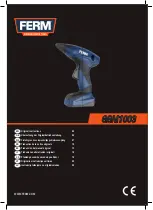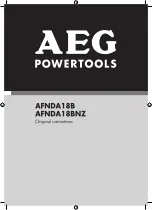
7
INSTALLATION
Selecting compressor (Fig. 2)
The air compressor must comply with the requirements
of EN60335-2-34.
Select a compressor that has ample pressure and air
output to assure cost-efficient operation. The graph
shows the relation between nailing frequency, applicable
pressure and compressor air output.
Thus, for example, if nailing takes place at a rate of
approximately 60 times per minute at a compression of
0.68 MPa (6.89 bar), a compressor with an air output
over 281 L/minute is required.
Pressure regulators must be used to limit air pressure to
the rated pressure of the tool where air supply pressure
exceeds the tool’s rated pressure. Failure to do so may
result in serious injury to tool operator or persons in the
vicinity.
Selecting air hose (Fig. 3)
Use an air hose as large and as short as possible to
assure continuous, efficient nailing operation. With an air
pressure of 0.49 MPa (4.9 bar), an air hose with an
internal diameter of over 8.0 mm and a length of less
than 20 m is recommended when the interval between
each nailing is 1 second. Air supply hoses shall have a
minimum working pressure rating of 1.03 MPa (10.3 bar)
or 150 percent of the maximum pressure produced in the
system whichever is higher.
CAUTION:
• Low air output of the compressor, or a long or smaller
diameter air hose in relation to the nailing frequency
may cause a decrease in the driving capability of the
tool.
Lubrication (Fig. 4)
To insure maximum performance, install an air set (oiler,
regulator, air filter) as close as possible to the tool. Adjust
the oiler so that one drop of oil will be provided for every
50 nails.
When an air set is not used, oil the tool with pneumatic
tool oil by placing 2 (two) or 3 (three) drops into the air
fitting. This should be done before and after use. For
proper lubrication, the tool must be fired a couple of
times after pneumatic tool oil is introduced.
(Fig. 5)
ASSEMBLY
Loading nailer
CAUTION:
• Always disconnect the hose before loading the nailer.
Depress the latch lever and open the door. And then
open the magazine cap.
(Fig. 6)
Lift and turn the coil support plate so that the coil support
plate points the graduation of the nail length that you are
going to install.
(Fig. 7)
Notice:
An improperly positioned coil support plate may cause
poor nail feed or malfunction of the tool.
(Fig. 8)
Place the nail coil over the coil support plate. Uncoil nails
enough to reach the feed claw. Place the first nail in the
driver channel and the second nail in the feed claw.
Place other uncoiled nails on feeder body. Make sure
that the nail coil is set properly in the magazine and close
the magazine cap.
Connecting air hose (Fig. 9)
Slip the air socket of the air hose onto the air fitting on
the nailer. Be sure that the air socket locks firmly into
position when installed onto the air fitting. A hose
coupling must be installed on or near the tool in such a
way that the pressure reservoir will discharge at the time
the air supply coupling is disconnected.
OPERATION
CAUTION:
• WITH THE TRIGGER HELD IN A HALF-PULLED
POSITION, an unexpected nailing could occur, if
contact element is allowed to re-contact against the
workpiece or the other surface under the influence of
recoil. In order to avoid this unexpected nailing,
perform as follows;
– Do not place the contact element against the
workpiece with excessive force.
– Pull the trigger fully and hold it on for 1 – 2 seconds
after nailing.
• Do not operate the tool without nails. It shortens the life
of the tool.
• Make sure all safety systems are in working order
before operation.
(Fig. 10)
– Only pulling trigger without contact element
contacting workpiece must not bring about the tool
firing.
(Fig. 11)
– Only contact element contacting workpiece without
pulling trigger must not bring about the tool firing.
Driving nails (Fig. 12)
Place the contact element against the workpiece and pull
the trigger, or pull the trigger first and then place the
contact element against the workpiece.
(Fig. 13)
The first method is for intermittent nailing, when you wish
to drive a nail carefully and very accurately.
The second method is for continuous nailing.
Use of sequential trip trigger (accessory)
To drive a nail, you may place the contact element
against the workpiece and pull the trigger.
CAUTION:
• WITH THE TRIGGER HELD IN A HALF-PULLED
POSITION, an unexpected nailing could occur, if
contact element is allowed to re-contact against the
workpiece or the other surface under the influence of
recoil. In order to avoid this unexpected nailing,
perform as follows;
– Do not place the contact element against the
workpiece with excessive force.
– Pull the trigger fully and hold it on for 1 – 2 seconds
after nailing.
Jammed nailer
CAUTION:
• Always disconnect the air hose and remove the nails
from the magazine before cleaning a jam.
(Fig. 14)
When the nailer becomes jammed, do as follows:
Open the magazine cap and remove the nail coil. Insert a
small rod or the like into the ejection port and tap it with a
hammer to drive out the nail jamming from the ejection
port. Reset the nail coil and close the magazine cap.








































